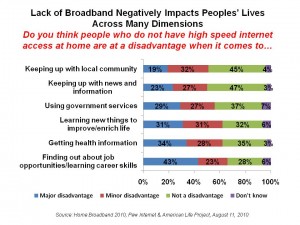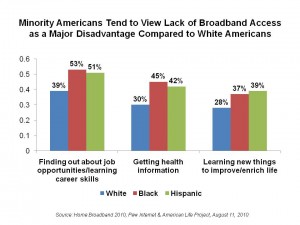 2 in 3 American adults use a broadband connection at home. Among those who don’t have high-speed access at home, most don’t go on the internet at home, and the others who do use dial-up connections (only 5% of adults).
2 in 3 American adults use a broadband connection at home. Among those who don’t have high-speed access at home, most don’t go on the internet at home, and the others who do use dial-up connections (only 5% of adults).
The Pew Internet & American Life Project knows more about Americans’ use of the internet than probably any other research organization, and their report, Home Broadband 2010, presents a comprehensive snapshot of how people in the U.S. are using the internet as of May 2010.
The most striking statistic in Pew’s survey is that growth of broadband among African-Americans grew in double-digits (22% year-on-year) while growth of broadband adoption slowed to 5% overall between 2009-10. This growth rate has cut the difference in the adoption of broadband@home between Whites and Blacks in half in just one year (67% compared to 56%).
Furthermore, Pew found that, “Minority Americans see a lack of broadband access as a major hindrance to accomplishing numerous tasks, while seniors are less likely to see the drawbacks of a lack high-speed access.”
There’s no Mars vs. Venus difference between Men and Women when it comes to adoption of broadband. However, there continue to be differences across age cohorts: greatest broadband penetration at home is among people under 50, with 80% of 18-29 year old’s having broadband at home and 75% of people 30-49 with it. Even for Boomers, 50-64, 63% (2 in 3) have broadband at home. Not surprisingly, broadband at home is lowest among seniors, Americans 65 and over, of whom only 1 in 3 have broadband at home. More affluent households have a greater adoption of broadband, as well as people with more education.
1 in 5 American adults doesn’t use the internet at all, whether via fast or slow connections. Why not? Pew aggregated 3 types of reasons why people avoid the internet:
- Lack of relevance: 48%, or 1 in 2, people who don’t use the internet at all are either not interested in it, feel it’s a waste of time, they’re too busy, or they don’t need or want it.
- Price/cost — for 21%, the internet is seen as too expensive, along with the fact that they don’t have a computer at home.
- Usability: 18% point to reasons such as finding the internet frustrating to navigate, worries about viruses, and lack of knowledge about how to go online.
Health Populi’s Hot Points: One of the sad hallmarks of American health care is the state of health disparities in the nation. Health disparities are, simply put, the gaps between the health status of minorities and non-minorities in the U.S. — in the forms of disease, disability, and premature death — based on the definition of the Department of Health and Human Services. There have been persistent disparities between whites and non-whites in infant mortality, cardiovascular disease, diabetes, HIV in fection/AIDS, cancer and lower rates of immunizations and cancer screening.
fection/AIDS, cancer and lower rates of immunizations and cancer screening.
The causes of these disparities boil down to two big issues: lack of access to care, and substandard quality of care, according to the National Partnership for Action to End Health Disparities, a project of DHHS.
Broadband is one antidote for addressing health disparities. The chart on the right illustrates an important difference between Minority Americans and White Americans: that Black and Hispanic adults believe lack of broadband connections to the internet disadvantages people in several key areas of life: in finding jobs and learning new things to improve their lives, and in accessing health information.
Note that 30% of White Americans say that lack of broadband access is a major disadvantage when it comes to accessing health information online. But 45% of Black Americans and 42% of Hispanic Americans see that broadband brings big advantages to those who go online for health information.
Here’s a case where health citizens know one of the cures for what ails them: now, will public policy heed their call? The FCC National Broadband Plan made a strong case for broadening broadband access to Americans without it. Hopefully, there’s political will to build out the backbone of broadband for the rest of America’s health citizens.




 I'm in amazing company here with other #digitalhealth innovators, thinkers and doers. Thank you to Cristian Cortez Fernandez and Zallud for this recognition; I'm grateful.
I'm in amazing company here with other #digitalhealth innovators, thinkers and doers. Thank you to Cristian Cortez Fernandez and Zallud for this recognition; I'm grateful. Jane was named as a member of the AHIP 2024 Advisory Board, joining some valued colleagues to prepare for the challenges and opportunities facing health plans, systems, and other industry stakeholders.
Jane was named as a member of the AHIP 2024 Advisory Board, joining some valued colleagues to prepare for the challenges and opportunities facing health plans, systems, and other industry stakeholders.  Join Jane at AHIP's annual meeting in Las Vegas: I'll be speaking, moderating a panel, and providing thought leadership on health consumers and bolstering equity, empowerment, and self-care.
Join Jane at AHIP's annual meeting in Las Vegas: I'll be speaking, moderating a panel, and providing thought leadership on health consumers and bolstering equity, empowerment, and self-care.